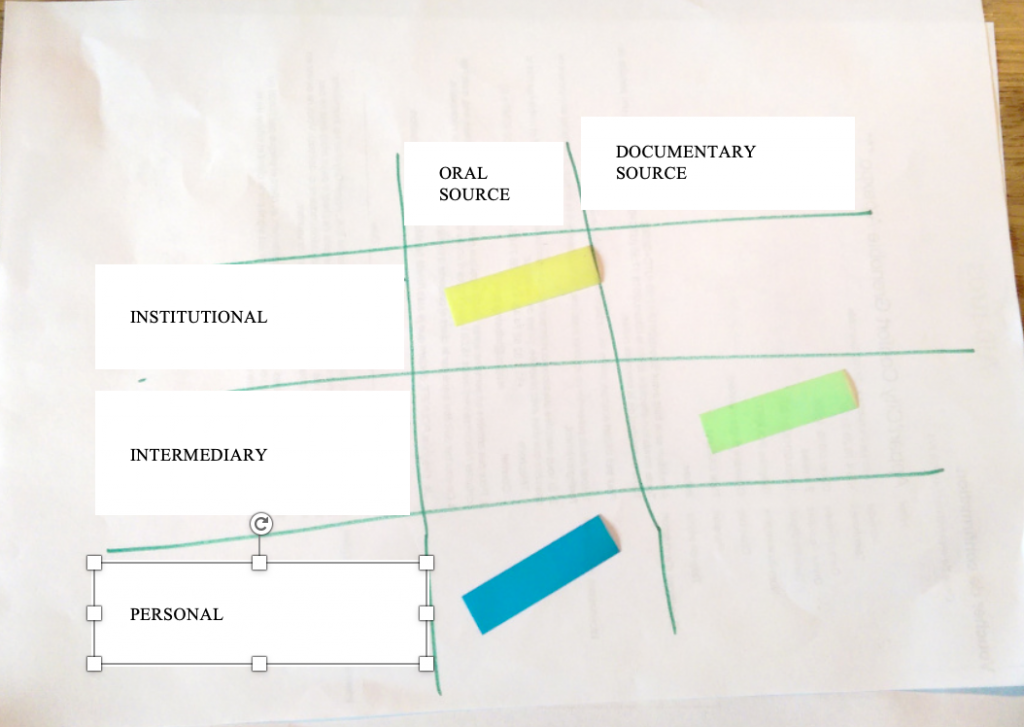This is an offline worshop. By the the end of it, learners will be able to differentiate among different types of information depending on its source (personal, intermediary, insitutional…).
General Objective
Preparation time for facilitator
Competence area
Time needed to complete activity (for learner)
Name of author
Support material needed for training
Resource originally created in
Introduction
This activity will build understanding in participants of what is meant by the term ‘information source’ and the various forms thereof. This will involve a series of explanations and exchanges. Oral participation is necessary for the workshop to go well. Facilitation tips: For more information on sources, see the relevant workshop plan.
Finding the origin of a source
To start, ask the group to discuss amongst themselves what they think an information source is. Leave 5 minutes. After this exchange, suggest the following definition: a source is a deliverer of information – in other words, the messenger. To know and trust a source is to know the information it carries is true, relevant and useful. For this, we need to know if we can believe a source or not. We therefore need to work out: is it trustworthy, reliable, uncertain or doubtful? For this initial exchange, show examples of information and ask their source, then discuss that source’s viability. Examples:
- My cousin told me a new cinema was opening in town
- I heard a new reality show was going to be made using clones
- Tweet from Billiam Proudson (some online stranger): ‘Mad, alcohol kills 2.8 million people a year according to this article‘.
Ideas to respond with:
1. The source is ‘my cousin’. We have to wonder how much can we trust this person. What does this depend on? Firstly, on the relationship we have to them. Do we know them well? Have they lied to us before? Are they known for telling the truth or for lying? It also depends on the where the person got their information. Where did the cousin hear what they are saying? If they can say, you can go check yourself.
2. The source is unknown. The information is therefore unreliable.
3. Here is a nice example of a Russian doll. We can see that the source is the Guardian (and not the tweet which is only sharing and commenting on this information). This newspaper is generally considered a serious source – we are supposed to take it seriously. But if we go further, we can see in the article that the information has been taken itself by the paper from a medical journal called The Lancet, coming from an international network of professionals working on global diseases called the Global Burden of Disease. If we go further, we can see that this network has done comprehensive research involving hundreds of studies. There are therefore hundreds of sources.
Understanding the different levels of sources
Following the previous activity, ask participants to name different kinds of sources and write them on post-its. Once you have 12 types, put them into categories on the board. To do this, first explain the different categories. They can be:
- documentaries
- oral sources
We can also class them as follows:
- institutional sources
- Intermediaries (‘middle men’)
- Personal
Documentary sources can be books, videos, newspapers, brochures, etc. Essentially: any kind of physical or digital document.
Oral sources can be discussions, conversations, interviews. Essentially: anything a person can relate to you directly.
Institutional sources have public authority, for example, government (ministerial, administrative, etc.). These are structured, organised and distribute official news. For example, a communication from a minister or a note from school administration.
Intermediary sources are organisational sources holding social legitimacy: associations, professional organisations, political parties, syndicates, etc. See here for a particular example from a European organisation representing animal welfare.
Personal sources: these are yours. It’s up to you to determine whether they are legitimate. Here, think again about the example ‘My cousin told me a new cinema was opening in town’. Do you trust them? What makes them a legitimate messenger? Where did they get this information? To clarify, you can give an example of an important personal source for detectives: witnesses! Journalists also have these which allows them exclusivity over information. For example, they might be informed by a lawyer about the details of an ongoing case. After detailing these different types of sources, make a table ‘Source Types’ with: 2 columns: oral sources | documentary sources 3 rows: institutional | intermediary | personal Then class the sources during the previous section by category.
